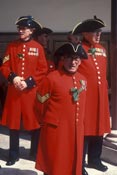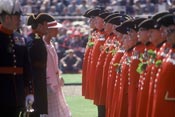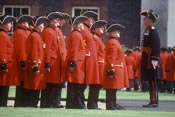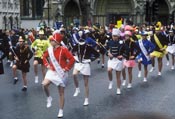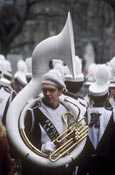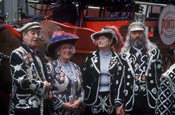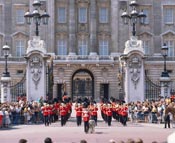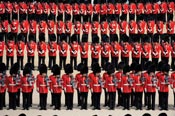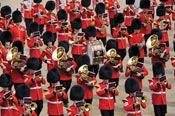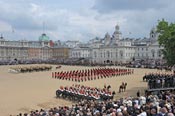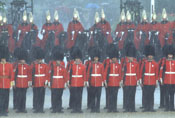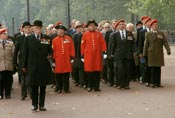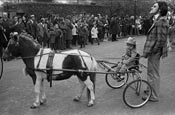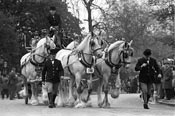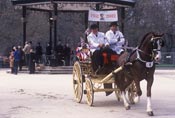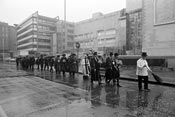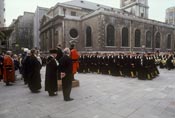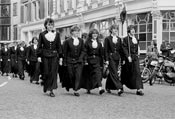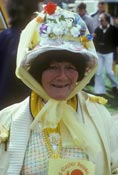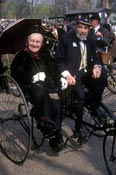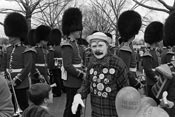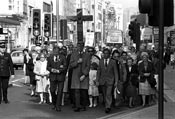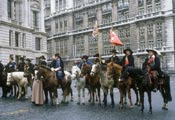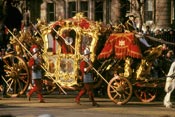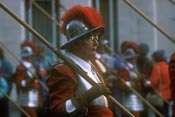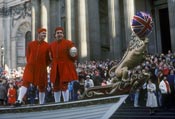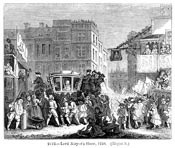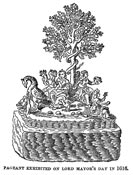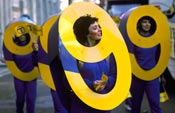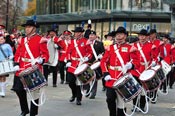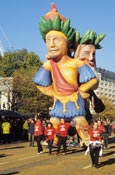
Here are a few processions and parades. The ‘Chelsea Pensioners’ are familiar public figures but their impressive Founder’s Day Parade is not open to the public. The Royal Hospital Chelsea was founded by Charles II in 1681 so naturally the parade is on or near Oak Apple Day, 29 March, when they all turn out in their ceremonial red coats and are reviewed by a member of the Royal Family. The march past is at a considerately slow pace. The New Year’s Day Parade started life in 1987 as ‘The Lord Mayor of Westminster’s Big Parade’ in answer, one feels, to the Lord Mayor’s Show in the City of London a couple of months earlier. This one is less commercial but has much more razzmatazz brought on by literally hundreds of American kids with their marching bands and majorettes, visiting groups from other countries and a contribution from each London borough, among many other things. Currently about 10,000 take part, in a procession two miles long, a rousing way to start the year. Trooping the Colour on the Sovereign’s official birthday is probably the most famous military parade in the world but the best way to see it is on TV on the second Saturday in June. Live attendance, unless you have a ticket to Horseguards Parade, can be a fun day out but you aren’t going to see very much! Remembrance Day parades are everywhere, but exceptionally elaborate around the Cenotaph in Whitehall. The London Harness Horse Parade was founded in 1885 to improve the welfare of the thousands of working horses in the capital at that time. The numbers of working horses declined but the parade went on and it is still an impressive spectacle. It was held in Regent’s Park for a century, then briefly in Battersea Park until 2006 when it moved out of London to the South of England Showground in Ardingly, West Sussex. The logistics became too much for central London, even on an Easter Monday. However the name lives on and so do the regular participants, who now come from all over England, though there are still some brewers drays and ‘totters’ about in London. Two diverting parades are The Vintners’ Procession along Upper Thames Street between Vintner’s Hall and St James Garlickhythe (not far) after the installation of the new Master, preceeded by a wine porter sweeping the street with a broom. The boys and girls of the Bluecoat School, Christ’s Hospital School in Horsham, march from St Paul’s Cathedral to the Guildhall in their distinctive uniforms, led by their fine band. The school was founded in 1552 near the Old Bailey and remained there until it moved to Horsham in 1902. The Easter Parade in Battersea Park is a demonstration of London’s diversity including the Band of the Brigade of Guards, ethnic groups, Pearlies, clowns, floats from the boroughs, vintage cyclists, re-enactors, you name them. Tyburn Walk, on the first Sunday in May, was in commemoration of 105 Catholic martyrs hanged during the Reformation and follows the the route of their last journey from Newgate Prison, now the Old Bailey, to Tyburn gallows, close to what is now Marble Arch. This was an impressive and well organised procession of several hundred catholics – which brought Oxford Street to a standstill and thus irritated police, shoppers, shop-keepers, Transport for London, and possibly some Protestants fundamentalists. It was announced that 2011 would be the last but, to be fair, Oxford Street on Sunday has become one of the busiest shopping streets in the world, a nightmare even without religious processions. However, regular Tyburn Walkers threaten to turn out anyway. We shall see...
The Lord Mayor’s Show is another of London’s great occasions. Officially it is the new Lord Mayor’s procession to the Royal Courts of Justice to swear allegiance to the Crown, which he does do, but over the centuries it has developed into a mighty show-off extravaganza to promote the City of London and business in general. Still it is an impressive display which includes not only the Lord Mayor in his Gold State Coach, but representatives from the ‘Great Twelve’ Livery Companies (out of 108), the Pikemen of the Honourable Artillery Company, the Royal Fusiliers, the Bluecoat School, winners of Dogget’s Coat and Badge, Pearly Kings and Queens, Gog and Magog. The show has been going on since 1751.
